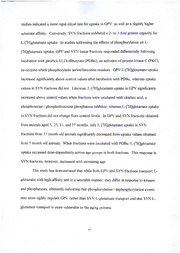
Properties of high-affinity L-Glutamate transport in glial- and neuronal-enriched fractions from rat brain PDF
Preview Properties of high-affinity L-Glutamate transport in glial- and neuronal-enriched fractions from rat brain
PROPERTIESOFHIGH-AFFINITYL-GLUTAMATETRANSPORTINGLIAL-AND NEURONAL-ENRICHEDFRACTIONSFROMRATBRAIN By KELLYEK.DANIELS ADISSERTATIONPRESENTEDTOTHEGRADUATESCHOOL OFTHEUNIVERSITYOFFLORIDAINPARTIALFULFILLMENT OFTHEREQUIREMENTSFORTHEDEGREEOF DOCTOROFPHILOSOPHY UNIVERSITYOFFLORIDA 1997 ThisworkisdedicatedtoMauriceandAltaBennett,MaggieDaniels,andLouiseFerrell, withgreatloveandfondremembrance. ACKNOWLEDGMENTS DuringmytimeasagraduatestudentattheUniversityofFlorida,Dr.WilliamG. LuttgeandDr.MaryJoKorolygavemeexceptionalguidanceandsupport;such generosityisrareandtrulyappreciated. IextendmuchgratitudetotheCenterfortheNeurobiologyofAgingandtothe BryanW.RobinsonNeurologicalFoundation,Inc.,forfinancialsupport. iii [ TABLEOFCONTENTS page ACKNOWLEDGMENTS iii ABSTRACT v CHAPTERS 1 BACKGROUNDANDSIGNIFICANCE 1 2 ISOLATIONOFGLIALANDNEURONALFRACTIONS 22 Introduction 22 ExperimentalProcedures 24 Results 32 Discussion 47 3 EFFECTOFPHOSPHORLYATIONONL-[3H]GLUTAMATEUPTAKE 53 Introduction 53 ExperimentalProcedures 57 Results 62 Discussion 64 4 EFFECTOFAGINGONL-3H]GLUTAMATEUPTAKE 75 Introduction 75 ExperimentalProcedures 77 Results 82 Discussion 8? 5CONCLUSIONS 93 REFERENCES 98 BIOGRAPHICALSKETCH 116 iv AbstractofDissertationPresentedtotheGraduateSchool oftheUniversityofFloridainPartialFulfillmentofthe RequirementsfortheDegreeofDoctorofPhilosophy PROPERTIESOFHIGH-AFFINITYL-GLUTAMATETRANSPORTINGLIAL-AND NEURONAL-ENRICHEDFRACTIONSFROMRATBRAIN By KellyeK.Daniels December,1997 Chairman:ThomasW.Vickroy,Ph.D. MajorDepartment:Neuroscience PriorstudieshaveestablishedthatterminationofL-glutamate-mediated neurotransmissionoccursthroughhigh-affinitytransporterslocatedonglialcellsand neurons. ForinvitrostudiesofL-glutamatetransport,animprovedthree-stepdensity gradientcentrifugationtechniquewasdevelopedtoisolateglial-(glialplasmalemmal vesiclesorGPV)andneuronal-(synaptosomesorSYN)enrichedvesiclesfromratbrain homogenates.Morphological,biochemical,andWesternblotanalysesconfirmedthehigh degreeofseparationbetweenGPVandSYNtissuefractions. GPVandSYNtissueswereusedtoevaluateL-glutamateuptake,toaddress phosphorylation/dephosphorylationeventsaspossibleregulatorymechanismsofL- glutamateuptake,andtodeterminetowhatextentagingmayalterthesemechanisms.L- [3H]GlutamateuptakebyGPVandSYNrevealedremarkedlysimilarproperties. Kinetic v studiesindicatedamorerapidinitialrateforuptakeinGPV,aswellasaslightlyhigher substrateaffinity. Conversely,SYNfractionsexhibiteda2-to3-foldgreatercapacityfor L-[3H]glutamateuptake. InstudiesaddressingtheeffectsofphosphorylationonL- [3H]glutamateuptake,GPVandSYNtissuefractionsrespondeddifferentiallyfollowing incubationwithphorbol-12,13-dibutyrate(PDBu),anactivatorofproteinkinaseC(PKC), anenzymewhichphosphorylatesserine/threonineresidues. GPVL-[3H]glutamateuptake increasedsignificantlyabovecontrolvaluesafterincubationwithPDBu,whereasuptake valuesinSYNfractionsdidnot. Likewise,L-[3H]glutamateuptakeinGPVsignificantly increasedabovecontrolvalueswhenfractionswereincubatedwithokadaicacid,a phosphoserine/phosphothreoninephosphataseinhibitor,whereasL-[3H]glutamateuptake inSYNfractionsdidnotchangefromcontrollevels. InGPVandSYNfractionsobtained fromanimalsaged5,25,31,and37months,onlyL-[3H]glutamateuptakeinSYN fractionsfrom37montholdanimalssignificantlydecreasedfromuptakevaluesobtained from5montholdanimals. WhenfractionswereincubatedwithPDBu,L-[3H]glutamate uptakeincreaseddose-dependentlyacrossagegroupsinbothfractions. Thisresponsein SYNfractions,however,decreasedwithincreasingage. ThisstudyhasdemonstratedthatwhilebothGPVandSYNfractionstransportL- glutamatewithhigh-affinityandinasaturablemanner,theydifferinresponsetokinases andphosphatases,ultimatelyindicatingthatphosphorylation/dephosphorylationevents maymoretightlyregulateGPVratherthanSYNL-glutamatetransportandthatSYNL- glutamatetransportismorevulnerabletotheagingprocess. vi CHAPTER 1 BACKGROUNDANDSIGNIFICANCE PropertiesofEAATransporters BiochemicalPropertiesandFunctions TheaminoacidsL-aspartateandL-glutamaterepresentthemajorexcitatory neurotransmittersinthemammalianbrain(Krnjevic,1970;Fonnum,1984). High-affinity transportersfortheseexcitatoryaminoacids(EAA)areessentialforrecapturingthe neurotransmitterL-glutamate,therebyterminatingitsextracellularactionsand maintainingahighconcentrationgradientbetweentheextracellularspaceandthecytosol ofnerveterminals(KannerandSchuldiner,1987;NichollsandAttwell,1990). Theability ofL-glutamatetocauseneuronaldamageandcelldeath,however,posesaspecial requirementforanefficientuptakesystem(Choi,1988,1994). Forseveralyearsithasbeenknown,primarilythroughtheworkofKannerand collaborators,thatL-glutamateuptakeiselectrogenicanddependentonexternalNa*and internalK+ions(KannerandSchuldiner,1987;Danboltetal.,1990). Detailedstudieson thestoichiometryofL-glutamateuptakehavebeencarriedoutonMullercells,a specializedformofglialcells(Attwelletal,1991;Bouvieretal,1992). Sincethesecells donotexpressL-glutamatereceptors,thecurrentelicitedbyL-glutamateprovidesa convenientindexofelectrogenicuptake. Analysesbasedonwholecellpatchclamp recordingsindicatethatL-glutamate(carryingonenetnegativechargeatphysiological 1 2 pH)istransportedintothecelltogetherwithtwosodiumionsandthatthereturnofthe carriertotheoutsideofthecelliscoupledwithanoutwardtransportofonepotassiumion andonehydroxylanion. ThemaintenanceofalowlevelofexternalL-glutamateisoneobviousfunctionof theL-glutamatetransporter. ThisfunctioniscrucialasL-glutamatebecomesneurotoxic whenitsextracellularconcentrationexceedsacertainlevel(Choietai,1987;Beal, 1992a,b). TheconcentrationatwhichL-glutamateexertsexcitotoxicactionsishardto determine,duetotheefficiencyofuptakeandthelackofnoncompetitive,irreversible blockers. Estimatesrangefromseveralhundredmicromolar(NichollsandAttwell,1990) toaslowas1micromolar(FrandsenandSchousboe,1990). Neuronaltoxicityisa consequenceofexcessivemembranedepolarizationassociatedwithswellingandan accumulationofcalciumrecruitedfromtheextracellularspaceorfromintracellularstores. TheimportanceofglialL-glutamatetransportersforreducingL-glutamateneurotoxicityis suggestedbyexperimentsshowingthatneuronsaremuchmoresensitivetoL-glutamate- inducedtoxicitywhengrownalonethanwhengrowninco-culturewithglia(Rosenberget ai,1992). Inconditionssuchashypoxiaandischemia,thedrivingforceforL-glutamate uptakecollapsesduetothebreakdownoftheelectrochemicalsodiumandpotassium gradients,andL-glutamatetransportiscompromisedorreversed(Szatkowskiand Attwell,1994). Infactthereisincreasingevidencetosuggestthattheextracellular overflowofL-glutamateinischemicandanoxicconditionsprimarilyreflectsinadequateor reversedL-glutamatetransportandthatexocytoticreleaseplaysaminorrole(Nicholls andAttwell,1990). 1 3 L-Glutamatedysfunctionhasbeenimplicatedinotherneurologicdisorderssuchas amyotrophiclateralsclerosis(ALS)(Plaitakis,1990;Rothsteinetai,1992;Shawetai, 1994;Rothsteinetal,1995;BristolandRothstein,1996;LeighandMeldrum,1996). High-affinity,sodium-dependenttransportofL-glutamatewasfoundtobemarkedly impairedinALSpatientsinthespinalcord,motorcortex,andsomatosensorycortex (Rothsteinetai,1992). ThesearethebrainregionsmostaffectedinALS. Thechanges werespecificforALS,astheywerenotobservedinHuntington'sdisease,Alzheimer's disease,ornonneurologicdiseasecontrols. ThisfindingledRothsteinandcolleagues (1992)toconcludethatdefectsintheclearanceofextracellularL-glutamate,secondaryto faultytransporterfunction,couldleadtoneurotoxiclevelsofextracellularL-glutamate andthusbepathogenicinALS. Regional/CellularLocalization Threesodium-dependenttransportersubtypeshavebeenidentifiedinratforebrain: L-glutamate/L-aspartatetransporter(GLAST)(Storcketai,1992),glialtransporter- (GLT-1)(Pinesetai,1992),andexcitatoryaminoacidcarrier-1(EAAC1)(Velaz- Fairclothetai,1996). Threesimilartransportershavebeenclonedfromhumanbrain,and theprovisionalhumanhomologshavebeentermedexcitatoryaminoacidtransporters (EAAT)-1,-2,and-3,correspondingwithgreaterthan90%sequencehomologyto GLAST,GLT-1,andEAAC1,respectively(Arrizaetai,1995). Afourthsubtype, EAAT4,hasbeenidentifiedinhumancerebellum(Fairmanetai,1995),andafifth subtype,EAAT5,hasbeenidentifiedinhumanretina(Arrizaetai,1997). 4 WithregardtothecellularandregionallocationsofL-glutamatetransporters, resultsfromimmunocytochemistry(Lehreetal,1995)andinsituhybridization(Torpet al,1994)indicatethattherearepronouncedregionaldifferencesintheexpressionofthe transporters. ThesestudieshavemappedGLASTmRNAtothePurkinjecelllayerofthe cerebellum,apparentlyassociatedwithBergmannglia(Storcketal,1992),aswellasto thecortexandhippocampus(Rothsteinetal,1994). Otherstudies,usinginsitu hybridizationforthecarboxyl-terminaldomainsofeachtransporter,initiallyreporteda lowlevelofGLASTimmunoreactivityinbothneuronsandastroglia(Rothsteinetal, 1994). Amino-terminaloligopeptideantibodieslocalizedGLASTtoastrocytes(Rothstein etal,1995;Lehreetal,1995;Schmittetai,1997). Inaddition,GLT-1ispresentin astrocytesthroughoutthebrain,withpredominantexpressionintelencephalicstructures, includingthehippocampus,neocortex,andstriatum(Danboltetal,1992;Rothsteinetal, 1994). However,bothradioactiveaswellasnon-radioactiveinsituhybridization techniqueshaveshownthatselectedneuronalpopulations(i.e.,thalamus,hypothalamus, andpyramidalcellsofthehippocampus)expressGLT-1mRNA(Torpetal,1994; Schmittetal,1996). TheobservationsthatGLT-1mRNAisexpressedinorbyneurons seemstobeatvariancewithotherstudies(Danboltetal,1992;Rothsteinetal,1994; Lehreetal,1995)whichfailedtodetectGLT-1proteininimmunoelectronmicroscopic preparations. Schmittandcolleagues(1996)maintainthatafailuretodetectGLT-1 proteininneuronalmembranesmaybearesultoftheproteinconcentrationbeingbelow themethod'sdetectionlimitsandthatattheelectronmicroscopicleveltheextremely
